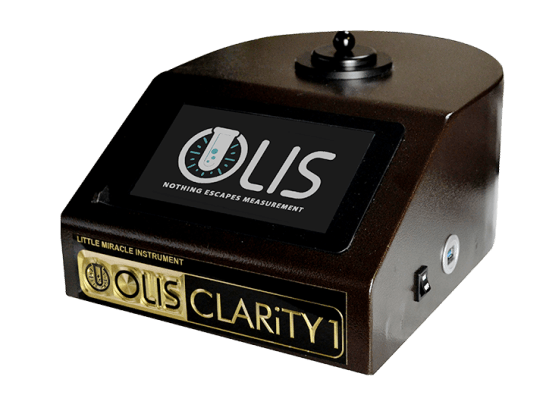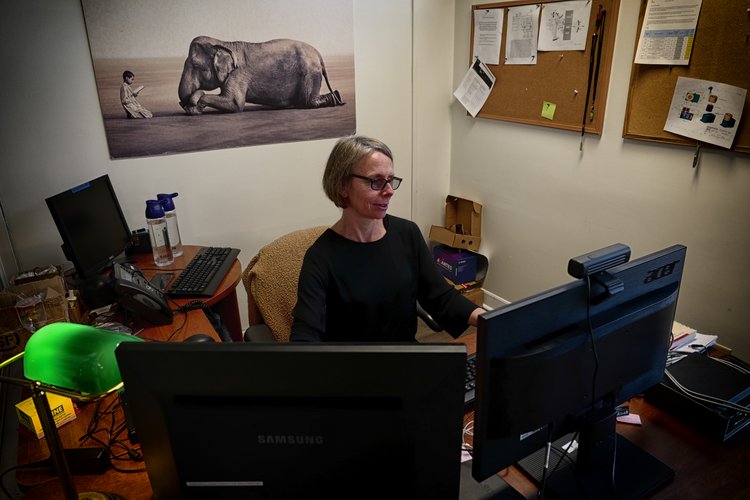Things about Circular Dichroism
Table of ContentsWhat Does Spectrophotometers Mean?The Of SpectrophotometersGet This Report about SpectrophotometersSome Of Uv/vis/nirExcitement About Circular DichroismThe Definitive Guide for Uv/vis/nirThe Buzz on Circular DichroismSpectrophotometers Fundamentals ExplainedUv/vis Fundamentals ExplainedThe Only Guide for Circularly Polarized LuminescenceAn Unbiased View of Uv/visEverything about Uv/vis8 Easy Facts About Uv/vis Explained
It is then scanned through the sample and the referral services. Portions of the occurrence wavelengths are transferred through, or reflected from, the sample and the referral. Electronic circuits transform the relative currents into linear transmission percentages and/or absorbance/concentration values.The transmission of a reference compound is set as a baseline (information) value, so the transmission of all other compounds are tape-recorded relative to the preliminary "zeroed" substance. The spectrophotometer then converts the transmission ratio into 'absorbency', the concentration of particular parts of the test sample relative to the preliminary compound.
Given that samples in these applications are not readily offered in big amounts, they are specifically fit to being analyzed in this non-destructive technique. In addition, precious sample can be saved by using a micro-volume platform where as little as 1u, L of sample is needed for complete analyses. A brief description of the procedure of spectrophotometry consists of comparing the absorbency of a blank sample that does not consist of a colored compound to a sample that contains a colored compound.
All about Uv/vis
In biochemical experiments, a chemical and/or physical residential or commercial property is chosen and the treatment that is utilized is specific to that residential or commercial property in order to obtain more information about the sample, such as the quantity, pureness, enzyme activity, etc. Spectrophotometry can be used for a number of techniques such as figuring out optimum wavelength absorbance of samples, identifying optimum p, H for absorbance of samples, figuring out concentrations of unidentified samples, and figuring out the p, Ka of different samples.: 21119 Spectrophotometry is likewise a useful process for protein purification and can also be utilized as an approach to create optical assays of a compound.
It is possible to understand the concentrations of a two component mix using the absorption spectra of the standard options of each element. To do this, it is needed to understand the extinction coefficient of this mix at 2 wave lengths and the termination coefficients of solutions which contain the recognized weights of the 2 elements.

Uv/vis Things To Know Before You Buy
Many spectrophotometers are used in the UV and visible areas of the spectrum, and a few of these instruments also run into the near-infrared area also. The concentration of a protein can be approximated by measuring the OD at 280 nm due to the existence of tryptophan, tyrosine and phenylalanine (https://www.4shared.com/u/FvsNFVfH/julieanndesalorenz30606.html).
This method needs a spectrophotometer capable of determining in the UV region with quartz cuvettes.: 135 Ultraviolet-visible (UV-vis) spectroscopy includes energy levels that delight electronic shifts. Absorption of UV-vis light delights molecules that are in ground-states to their excited-states.
20. 8 O.D. Ink manufacturers, printing companies, fabrics vendors, and much more, require the information provided through colorimetry. They take readings in the region of every 520 nanometers along the noticeable region, and produce a spectral reflectance curve or an information stream for alternative presentations. These curves can be used to evaluate a new batch of colorant to inspect if it makes a match to requirements, e.
Getting My Uv/vis/nir To Work
Conventional noticeable region spectrophotometers can not detect if a colorant or the base material has fluorescence. This can make it challenging to manage color issues if for example one or more of the printing inks is fluorescent. Where a colorant contains fluorescence, a bi-spectral fluorescent spectrophotometer is utilized (https://www.pearltrees.com/olisclarity1#item574664694). There are 2 major setups for visual spectrum spectrophotometers, d/8 (round) and 0/45.
Researchers utilize this instrument to measure the amount of compounds in a sample. If the substance is more focused more light will be taken in by the sample; within little varieties, the Beer, Lambert law holds and the absorbance in between samples vary with concentration linearly. In the case of printing measurements 2 alternative settings are typically utilized- without/with uv filter to control better the impact of uv brighteners within the paper stock.
Not known Details About Uv/vis/nir
Some applications require small volume measurements which can be performed with micro-volume platforms. As explained in the applications area, spectrophotometry can be used in both qualitative and quantitative analysis of DNA, RNA, and proteins. Qualitative analysis can be utilized and spectrophotometers are used to tape-record spectra of compounds by scanning broad wavelength areas to identify the absorbance homes (the strength of the color) of the substance at each wavelength.

Getting The Circular Dichroism To Work
One significant factor is the type of photosensors that are available for various spectral areas, however infrared measurement is likewise tough since virtually everything produces IR as thermal radiation, especially at wavelengths beyond about 5 m. Another issue is that many materials such as glass and plastic absorb infrared, making it incompatible as an optical medium.
Recovered Dec 23, 2018. Essential Lab Techniques for Biochemistry and Biotechnology (2nd ed.). The important guide to analytical chemistry.
Oke, J. B.; Gunn, J. E.
The Facts About Uv/vis/nir Revealed

Ninfa AJ, Ballou DP, Benore M (2015 ). Fundamental Lab Approaches for Biochemistry and Biotechnology (3, rev. ed.). circular dichroism. Lab Devices.
Uv/vis/nir for Beginners
Retrieved Jul 4, 2018. Trumbo, Toni A.; Schultz, Emeric; Borland, Michael G.; Pugh, Michael Eugene (April 27, 2013). "Applied Spectrophotometry: Analysis of a Biochemical Mixture". Biochemistry and Molecular Biology Education. 41 (4 ): 24250. doi:10. 1002/bmb. 20694. PMID 23625877. (PDF). www. mt.com. Mettler-Toledo AG, Analytical. 2016. Obtained Dec 23, 2018. Cortez, C.; Szepaniuk, A.; Gomes da Silva, L.
"Checking Out Proteins Filtration Strategies Animations as Tools for the Biochemistry Mentor". Journal of Biochemistry Education. 8 (2 ): 12. doi:. Garrett RH, Grisham CM (2013 ). Biochemistry. Belmont, CA: Cengage. p. 106. ISBN 978-1133106296. OCLC 801650341. Holiday, Ensor Roslyn (May 27, 1936). "Spectrophotometry of proteins". Biochemical Journal. 30 (10 ): 17951803. doi:10. 1042/bj0301795.
PMID 16746224. Hermannsson, Ptur G.; Vannahme, Christoph; Smith, Cameron L. C.; Srensen, Kristian T.; Kristensen, Anders (2015 ). "Refractive index dispersion sensing utilizing an array of photonic crystal resonant reflectors". Applied Physics Letters. 107 (6 ): 061101. Bibcode:2015 Ap, Ph, L. 107f1101H. doi:10. 1063/1. 4928548. S2CID 62897708. Mavrodineanu R, Schultz JI, Menis O, eds.
Everything about Uv/vis/nir
U.S. Department of Commerce National Bureau of Standards special publication; 378. Washington, D.C.: U.S. National Bureau of Standards.
The process starts with a regulated light source that illuminates the analyzed sample. In the case of reflection, as this light engages with the sample, some is taken in this or released. The produced light travels to the detector, which is examined, measured, and provided as industry-standard color scales and indices.
Market governing bodies normally specify specific metrics for specific products, such as Tomato and Coffee indices. The simplified math appears like this: Where R is the reflection coefficient. All terms are evaluated over the noticeable spectrum from 400 to 700 nm. In the case of transmission, when the light connects with the sample, it is either taken in, reflected, or transmitted.
Things about Uv/vis
Examples include APHA (American Public Health Association) for watercolor and pureness analysis, ASTM D1500 for petrochemical color analysis, edible oil indices utilized in food, and color analyses of drinks. All terms are examined over the visible spectrum from 400 to 700 nm.
Image Credit: Matej Kastelic/ Dr. Arnold J. Beckman and his colleagues at the National Technologies Laboratories first invented the spectrophotometer in 1940. In 1935 Beckman founded the business, and the discovery of the spectrophotometer was their most ground-breaking creation. Dr. Bruce Merrifield, a Nobel prize-winning biochemist, stated that the development of the spectrophotometer was "most likely the most important instrument ever established towards the improvement of bioscience." Before the discovery of the spectrophotometer, chemical analyses took weeks to complete, with 25% precision.
All about Uv/vis
Over time, researchers kept enhancing the spectrophotometer design to boost its efficiency. The UV capabilities of the model B spectrophotometer were enhanced by replacing the glass prism with a quartz prism.
Generally, a spectrophotometer is made up of two instruments, namely, a spectrometer and a photometer. A fundamental spectrophotometer includes a light source, a monochromator, a collimator for straight light beam transmission, a cuvette to position a sample, and a photoelectric detector.
Rumored Buzz on Uv/vis
There are various types of spectrophotometers in numerous shapes and sizes, each with its own function or functionality. A spectrophotometer identifies just how much light is reflected by chemical elements. circularly polarized luminescence. It measures the distinction in light strength based upon the overall quantity of light presented to a sample and the amount of light beam that travels through the sample service
Based on the instrument's style, the sample is positioned between the spectrometer and the photometer. After the light is gone through the sample, the photometer determines its intensity and shows the reading. A spectrophotometer is used to identify the concentration of both colorless and colored solutes in a solution. This instrument is used to identify the rate of a response.